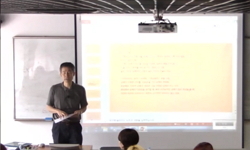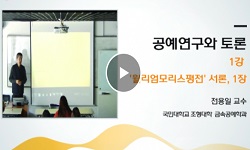이 글은 입석사 마애불좌상이 1090년, 즉 11세기 후반이라는 시기에 제작되었음이 분명히 밝혀짐에 따라, 이를 기준작으로 하여 고려전기 불교조각사에 있어 원주지역 조각들을 새롭게 자리...
http://chineseinput.net/에서 pinyin(병음)방식으로 중국어를 변환할 수 있습니다.
변환된 중국어를 복사하여 사용하시면 됩니다.
- 中文 을 입력하시려면 zhongwen을 입력하시고 space를누르시면됩니다.
- 北京 을 입력하시려면 beijing을 입력하시고 space를 누르시면 됩니다.
고려전기 원주지역의 불교조각_preprint
한글로보기https://www.riss.kr/link?id=G3806108
- 저자
- 발행기관
-
발행연도
2001년
-
작성언어
Korean
- 주제어
-
자료형태
한국연구재단(NRF)
-
0
상세조회 -
0
다운로드
부가정보
국문 초록 (Abstract)
그 대상은 원주에서 출토된 철불 및 석불이 중심이 되겠지만, 이 중 서산 보원사지출토 철불좌상과 동일한 양식적 특징을 보여주는 국립중앙박물관소장 철불좌상 3구는 연구의 대상에서 제외하였다. 10세기 중엽이라는 대략의 제작시기를 알 수 있는 이들 3구의 철불좌상은 이 글에서 논의하고자 하는 원주지역 대부분의 석불좌상과는 제작시기에 따른 양식적 차이를 분명하게 보여주고 있기 때문이다. 이를 제외하고 3구의 불좌상보다 제작시기가 늦지만 동일한 양식적 특징을 보여주는 것이 분명한 국립중앙박물관 소장 철조 및 석조불좌상과 원주에 남겨져 있는 석불좌상들을 연구의 대상으로 하였다. 뿐만 아니라 최근 강원도 유형문화재를 지정하는 과정에서 새롭게 알려진 매지리 석조보살입상(그림 28)을 위시하여 봉산 2동의 신선암 보살입상(그림 27), 봉산동 석조보살입상(그림 25) 등 5구의 석조보살입상 역시 동일한 양식적 특징을 보여주고 있어 함께 포함하여 서술토록 하겠다.
이 글은 입석사 마애불좌상이 1090년, 즉 11세기 후반이라는 시기에 제작되었음이 분명히 밝혀짐에 따라, 이를 기준작으로 하여 고려전기 불교조각사에 있어 원주지역 조각들을 새롭게 자리매김해보고자 하는 것이다. 아울러 고려시대 전기라는 시기에 이곳 원주지역에 이토록 많은 불교유물이 존재하는데는 어떤 이유가 있을까. 왜 고려전기라는 특정한 시기에만 집중되어 있으며, 그 시기는 또 구체적으로 언제인가. 그리고 고려 후기 및 그 이후에 해당하는 불교조각은 또 왜 없는가. 이 글은 이같은 의문에 대한 해답을 모색해 보고자 하였다.
그 대상은 원주에서 출토된 철불 및 석불이 중심이 되겠지만, 이 중 서산 보원사지출토 철불좌상과 동일한 양식적 특징을 보여주는 국립중앙박물관소장 철불좌상 3구는 연구의 대상에서 제외하였다. 10세기 중엽이라는 대략의 제작시기를 알 수 있는 이들 3구의 철불좌상은 이 글에서 논의하고자 하는 원주지역 대부분의 석불좌상과는 제작시기에 따른 양식적 차이를 분명하게 보여주고 있기 때문이다. 이를 제외하고 3구의 불좌상보다 제작시기가 늦지만 동일한 양식적 특징을 보여주는 것이 분명한 국립중앙박물관 소장 철조 및 석조불좌상과 원주에 남겨져 있는 석불좌상들을 연구의 대상으로 하였다. 뿐만 아니라 최근 강원도 유형문화재를 지정하는 과정에서 새롭게 알려진 매지리 석조보살입상(그림 28)을 위시하여 봉산 2동의 신선암 보살입상(그림 27), 봉산동 석조보살입상(그림 25) 등 5구의 석조보살입상 역시 동일한 양식적 특징을 보여주고 있어 함께 포함하여 서술토록 하겠다.
다국어 초록 (Multilingual Abstract)
They have not drawn scholarly attention most probably because they seemed to include no datable pieces. Fortunately we now have one datable pieces. A rock-carved Buddha of Ipsŏk-sa 立石寺. Which has an inscription of the 5th year of Yuanyou(1090). It is anticipated that it would provide on important clue for dating other similar piece.
This article is the first attempt to deal with the Buddhist sculpture of Wŏnju in a single group in the light of the dated Buddha of Ipsŏk-sa. In this attempt. I explore the reason for the creation of a large number of Buddhist sculptures in this area and the more specific date of their creation within the first half of the Koryŏ period.
Several points are presented in conclusion. First, all the sculpures from this area share the same stylistic characteristics and datable roughly to the middle to the late 11th century. The geographical location of Wŏnju seems to have contributed to the emergence of this partucular style. Wŏnju was under the strong influence of Kaegyŏng 開京, the capital of Koryŏ, connected through the South Han river. Especially Wŏnju enjoyed prosperity during the 11th century, when the Hŭngwŏn granary 興原倉 was installed in the city. Thus, the Buddhist sculpture of Wŏnju was also closely associated with the style of the capital area. Unfortunely sculpture made in Kaegyŏng during the 11th century; so it is not possible to make stylistic comparison between these two reions. It is certain. however, that the Buddhist sculptures of Wŏnju had their patrons who had a close relatinship with central capital area and great authority over Wŏnju. Cultural communication with other area through river transportation must have promoted the refinement of the sculpture of this area.
I suggest that the sculptural style of Wŏnju in the 11th century would have been quite similar to that of Kaegyŏng would be supported by the comparison between a rock-carved Buddha of Ipsŏk-sa and the sculptural decoration on the relic stupa of the national patriarch Chigwang 智光國師
A number of Buddhist sculptures are extant in the Wŏnju 原州 area unlike other parts of the Kangwŏn province. Most of them are dated to the First half of the Koryŏ period. Thrteen Pieces are present in situ. while five iron images and two stone i...
A number of Buddhist sculptures are extant in the Wŏnju 原州 area unlike other parts of the Kangwŏn province. Most of them are dated to the First half of the Koryŏ period. Thrteen Pieces are present in situ. while five iron images and two stone images are stored in the collection of the National Museum. The fact that all the twenty pieces are created in a small area within a short span of time deserves partucular attention. but no previous study has focused on these objects.
They have not drawn scholarly attention most probably because they seemed to include no datable pieces. Fortunately we now have one datable pieces. A rock-carved Buddha of Ipsŏk-sa 立石寺. Which has an inscription of the 5th year of Yuanyou(1090). It is anticipated that it would provide on important clue for dating other similar piece.
This article is the first attempt to deal with the Buddhist sculpture of Wŏnju in a single group in the light of the dated Buddha of Ipsŏk-sa. In this attempt. I explore the reason for the creation of a large number of Buddhist sculptures in this area and the more specific date of their creation within the first half of the Koryŏ period.
Several points are presented in conclusion. First, all the sculpures from this area share the same stylistic characteristics and datable roughly to the middle to the late 11th century. The geographical location of Wŏnju seems to have contributed to the emergence of this partucular style. Wŏnju was under the strong influence of Kaegyŏng 開京, the capital of Koryŏ, connected through the South Han river. Especially Wŏnju enjoyed prosperity during the 11th century, when the Hŭngwŏn granary 興原倉 was installed in the city. Thus, the Buddhist sculpture of Wŏnju was also closely associated with the style of the capital area. Unfortunely sculpture made in Kaegyŏng during the 11th century; so it is not possible to make stylistic comparison between these two reions. It is certain. however, that the Buddhist sculptures of Wŏnju had their patrons who had a close relatinship with central capital area and great authority over Wŏnju. Cultural communication with other area through river transportation must have promoted the refinement of the sculpture of this area.
I suggest that the sculptural style of Wŏnju in the 11th century would have been quite similar to that of Kaegyŏng would be supported by the comparison between a rock-carved Buddha of Ipsŏk-sa and the sculptural decoration on the relic stupa of the national patriarch Chigwang 智光國師
국문 초록 (Abstract)
과제와 표현체의 서명 다름.
주 초록의 내용은 머리말의 내용을 요약 제시하였음.
프리프린트와 게재학술지논문의 내용은 동일하나 편집의 차이로 페이지수 다름. 과제와 표현체의 서명 다름. 주 초록의 내용은 머리말의 내용을 요약 제시하였음.
프리프린트와 게재학술지논문의 내용은 동일하나 편집의 차이로 페이지수 다름.
과제와 표현체의 서명 다름.
주 초록의 내용은 머리말의 내용을 요약 제시하였음.
국문 초록 (Abstract)
Ⅱ. 고려전기 원주지역 불‧보살상의 조성배경
Ⅲ. 고려전기 원주지역 불‧보살상의 현상 및 특징
1. 불좌상
2. 보살입상
Ⅳ. 양식적 특징과 제작연대
Ⅴ. 맺음말 -조각사적 의의-
Ⅰ. 머리말 Ⅱ. 고려전기 원주지역 불‧보살상의 조성배경 Ⅲ. 고려전기 원주지역 불‧보살상의 현상 및 특징 1. 불좌상 2. 보살입상 Ⅳ. 양식적 특...
Ⅰ. 머리말
Ⅱ. 고려전기 원주지역 불‧보살상의 조성배경
Ⅲ. 고려전기 원주지역 불‧보살상의 현상 및 특징
1. 불좌상
2. 보살입상
Ⅳ. 양식적 특징과 제작연대
Ⅴ. 맺음말 -조각사적 의의-











